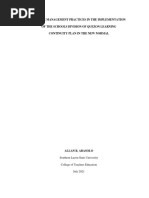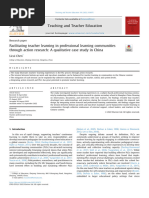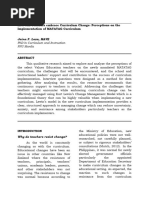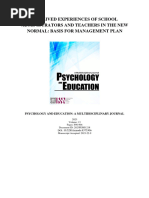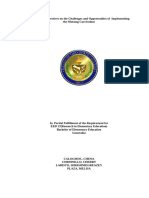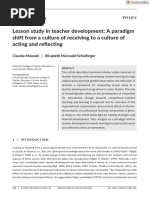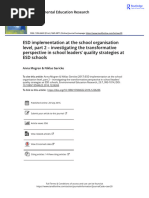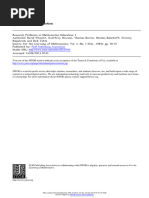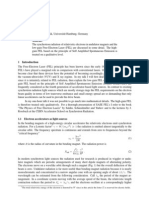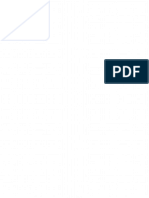Appendix HPGD1103
Appendix HPGD1103
Uploaded by
Store Bangfey1Copyright:
Available Formats
Appendix HPGD1103
Appendix HPGD1103
Uploaded by
Store Bangfey1Copyright
Available Formats
Share this document
Did you find this document useful?
Is this content inappropriate?
Copyright:
Available Formats
Appendix HPGD1103
Appendix HPGD1103
Uploaded by
Store Bangfey1Copyright:
Available Formats
See discussions, stats, and author profiles for this publication at: https://www.researchgate.
net/publication/347287379
Leading curriculum changes in schools: The role of school principals as
perceived by teachers
Article in Perspectives in Education · December 2020
DOI: 10.18820/2519593X/pie.v38.i2.10
CITATION READS
1 857
1 author:
Arrie Van Wyk
North-West University
5 PUBLICATIONS 15 CITATIONS
SEE PROFILE
Some of the authors of this publication are also working on these related projects:
Two articles: 1: Resistance to change 2: School improvement View project
All content following this page was uploaded by Arrie Van Wyk on 23 June 2021.
The user has requested enhancement of the downloaded file.
Research Article
LEADING CURRICULUM
AUTHOR:
Dr A Van Wyk1
AFFILIATION: CHANGES IN SCHOOLS: THE
School for Professional
1
Studies in Education: Education ROLE OF SCHOOL PRINCIPALS
Management and Leadership,
North-West University AS PERCEIVED BY TEACHERS
DOI: http://dx.doi.
org/10.18820/2519593X/pie.v38.
i2.10 ABSTRACT
e-ISSN 2519-593X The purpose of this article was to determine the views of teachers
regarding the leading role of principals during curriculum changes
Perspectives in Education
in schools. The research was quantitative in nature, with one
2020 38(2): 155-167 qualitative section and was based on a post-positivist worldview.
The qualitative section serves to inform the reader explicitly on
PUBLISHED: leadership issues that are important during curriculum changes.
04 December 2020 Eight hundred and eighty-four teachers from 67 schools formed the
sample. Any change initiative always has an element of resistance
to it that should be considered by principals, also when changes
in the curriculum are being created. Bearing in mind the views
of teachers, the effect of resistance to curriculum changes could
be minimised. Principals could be in a better position to steer the
curriculum changes in schools in the right direction. Teachers will,
as a result, be in a better position to do their work properly to the
benefit of the learners and, eventually, to the benefit of society.
Keywords: change, curriculum, leadership, principals, readiness
for change, resistance, schools, teachers
1. INTRODUCTION
Since the inception of the democratic education system
in South Africa in 1994, many curriculum changes have
taken place to rectify the disparities that existed in the
education departments prior to 1994 (Van Wyk & Van
der Westhuizen, 2015). The aim was to create a single,
uniform curriculum for all schools. As change is a global
phenomenon that constantly takes place in organisations,
one can assume that another reason for the changes in
the curriculum was to create work environments that are
more competitive (Specht, Kuonath, Pachler, Weisweiler &
Frey, 2017). Change agents often face difficulties in leading
curriculum changes successfully. It has been maintained
Published by the UFS
that in the South African schooling context, notwithstanding
http://journals.ufs.ac.za/index.php/pie interventions of various institutions and the government, the
© Creative Commons curriculum changes in the schooling system do not seem to
With Attribution (CC-BY) come to fruition. It seems that most of the old challenges
regarding the curriculum still remain, while new challenges
pertaining to the curriculum have come to the fore (Van Wyk
202038(2):155-167 155 http://dx.doi.org/10.18820/2519593X/pie.v38.i2.10
Perspectives in Education 2020: 38(2)
& Van der Westhuizen, 2015). In this regard, one can refer to the rapid curriculum changes
that have taken place, such as Outcomes-Based Education (OBE), the National Curriculum
Statement, the Revised Curriculum Statement and, presently, the Curriculum and Assessment
Policy Statement (CAPS) (Gumede & Biyase, 2016).
2. STATEMENT OF THE PROBLEM
Gigliotti, Vardaman, Marshall and Gonzalez (2018) are of the view that almost 70% of
change initiatives in organisations fail, although the survival of organisations relies on the
successful implementation of change. In the school environment, the reasons for such failure
can be classroom-related, school-related and related to external factors (Holborn, 2013). The
challenges of the successful implementation of curriculum changes could be anything from
the content and pedagogical knowledge and behaviour of teachers, to learner poverty and a
lack of resources (Equal Education, 2015; Phakahti, 2013). According to Gigliotti et al. (2018),
other aspects in the schooling system such as participation of and support for teachers and
the knowledge of the content of the curriculum change, can also facilitate or hinder the buy-in
of teachers. Other aspects relate to school environments that are plagued by drugs, gangs
and weapons, all of which threaten the culture of teaching and learning (Mncube & Madikizela-
Madiya, 2014).
In the South African context, leadership and management issues in the schooling system
also prevent change initiatives from being successful (Van der Westhuizen & Van Vuuren,
2007). Van der Westhuizen and Van Vuuren (2007) maintain that some principals are appointed,
for example, based on their learners’ good results. This criterion does not guarantee that
principals will be good at leading curriculum changes in a school. The minimum requirements
of seven years’ teaching experience, as prescribed in the Personnel Administrative Measures
(PAM) (2016), to be appointed in a principal post can be an advantage for the principal as
well as the school. However, it is the view of Van der Westhuizen (2015) that the management
and leading of a school require an individual with specialised skills and knowledge that must
be modernised repeatedly and employed in a practical manner. It thus implies that teaching
experience alone is not sufficient to be a successful principal, but training in educational
management and leadership issues becomes another criterion. According to Zuze and Juan
(2020), this criterion is crucial for principals to acquire as they have been tasked over the
past 20 years with implementing policies and programmes as well as raising the academic
standards in schools. Furthermore, the PAM sets out the fundamental duties of school
principals, which include among others, policy enactment and the management of teachers,
learners, information, infrastructure and school discipline (Zuze & Juan, 2020). These roles
have been refined in the Policy on the South African Standard for Principalship (RSA, 2016),
which sets out eight interdependent areas of which the management of the curriculum forms
one of the core activities of the principal.
In addition, in order to respond to the new curriculum in the classroom and the management
and leadership challenges in schools, training opportunities for teachers and principals have
also been made available (Gaza, 2012). Notwithstanding these interventions, most schools,
especially schools in poor communities, are not performing at a satisfactory level and the
envisaged curriculum changes have not yet been realised. However, there is evidence that
some schools in poor communities nevertheless excel, implying that not all schools in these
areas perform poorly (Ngcobo & Tikly, 2010). In view of the latter, there must be other missing
aspects in the South African schooling system that have not yet been accounted for that
202038(2):156-167 156 http://dx.doi.org/10.18820/2519593X/pie.v38.i2.10
Van Wyk Leading curriculum changes in schools
impede on the readiness of schools for the envisaged curriculum changes. Based on the
aforementioned observations and remarks regarding leadership and frequent curriculum
changes in the schooling system, the research reported in the remainder of this article was
guided by the following question: What are the perceptions of teachers regarding the leading
role of principals in curriculum changes in schools? The research was based on the following
conceptual and theoretical framework.
3. CONCEPTUAL AND THEORETICAL FRAMEWORK
This section covers the conceptual and theoretical framework on which the empirical research
regarding the perceptions of teachers pertaining to the leading role of principals in curriculum
changes in schools was based.
3.1 Change and resistance to change
Change is an ever-present phenomenon in organisations. It happens to renew organisations
and should be dealt with skilfully for it to be successful (Mohamed & Abdel-Ghany, 2014).
The element of resistance is always present during change (Van Wyk & Van der Westhuizen,
2015). Resistance takes place when there is change, but also when there is no change in
organisations (Van Wyk & Van der Westhuizen, 2015). The skilful handling of change minimises
the possibility of resistance. However, employees seldom exhibit change-resistant behaviour
from the onset without first considering the negative consequences for themselves (Mohamed
& Abdel-Ghany, 2014). Choi and Ruona (2011) hold similar views, stating that individuals are
not naturally inclined to resist change but, instead, are annoyed with the consequences that
the change might bring and the way change is forced upon them. Change or non-change in
organisations each has the potential to manifest in revolutionary or reactionary resistance
(Van der Westhuizen & Theron, 2014). Both views of resistance have relevancy for education
and serve as aids to let change happen in schools (Zimmerman, 2006). This phenomenon can
best be described by Kurt Lewin’s force-field theory, which deals with driving forces on the one
side and restraining forces on the other (Lewin, 1947a; Lewin, 1947b). Choi and Ruona (2011)
maintain, referencing Lewin (1947a), that driving forces, for instance stakeholders in schools,
mostly occur when an organisation fails to effect a change. Parents and teachers as driving
forces have the interest of the school at heart and one assumes that they will do anything
positive to let changes happen in the school. However, they could also be hampering the
change process as restraining forces, especially when they believe that the change process
is to the detriment of the school.
3.2 Readiness for change
Readiness for change refers to the perceptions, beliefs, attitudes and intentions of the
members of organisations regarding the extent to which changes are needed and the capacity
of the organisation to effect the changes (Armenakis & Bedeian, 1999; Eby, Adams, Russell
& Gaby, 2000; Jansen, 2000; Jones, Jimmieson & Griffiths, 2005). Readiness is all about
employees’ perceptions of their competencies to implement the change (Combe, 2014; Holt,
Armenakis, Feild & Harris, 2007). Being prepared for change implies that the individual needs
to be transformed physically and cognitively so that he or she will have control over, and
the capacity to, respond to a challenge (Weiner, 2009). During a time of change readiness,
organisational members are more likely to initiate change, utilise greater effort in support of
change and display greater determination in the face of obstacles during the enactment of
the change.
202038(2):157-167 157 http://dx.doi.org/10.18820/2519593X/pie.v38.i2.10
Perspectives in Education 2020: 38(2)
The systems and the management of organisations as well as the relationships within
the organisation should be conducive for individuals to embrace the change process.
Organisational readiness can also be measured by the organisation’s financial, material,
human and informational resources that can be applied to the change, as well as by the
psychological willingness of affected people to cooperate in bringing the change to fruition
(Wallinga, 2008). The consequence of being ready will be the effective implementation of new
ideas, programme processes or technology. Organisational members whose commitment to
change is based on “want to” motives rather than “need to” motives exhibit cooperative and
supportive behaviour (Weiner, 2009). By contrast, when organisational readiness for change
is low or non-existent, staff will resist initiating change, put less effort into the implementation
thereof and exhibit less compliant behaviour.
In an effort to integrate the concepts discussed above, the next section deals with the
formulation of a theoretical framework. Kotter’s eight-step change model served as the
backbone on which the research of the perceptions of teachers regarding the leading role of
the principal in curriculum change was based.
3.3 Kotter’s eight-step change model
3.3.1 Increase urgency
During this phase, teachers want principals to give reasons for the change and an explanation
of how it will affect them. The crisis with the curriculum and the opportunities that can be
established should be emphasised. Aspects that can be emphasised as reasons for change
in the curriculum revolve around teachers’ uncertainties of how to implement the curriculum,
their negative reactions and resistance, as they find it difficult to maintain a balance between
teaching and assessment time. Other reasons are, for instance, the fact that South African
learners score poorly in literacy and numeracy tests compared to learners from other African
countries (Mouton, Louw & Strydom, 2012).
In addition, reports showed that the literacy and numeracy rates of learners in South
Africa are among the lowest of their peers, despite the huge amount spent on education each
year (Mouton et al., 2012). To intensify the need for curriculum change, principals could use
examples of opportunities, such as the envisaged coding and robotics that will be part of a
new curriculum to prepare learners for the Fourth Industrial Revolution in South Africa. It can
also be emphasised that the new curriculum will prepare learners to apply their digital and
ICT skills to work from their homes to solve a problem such as the current COVID-19 crisis
(Business Tech, 2019). Principals should enable teachers to talk about and participate in
discussions about changes in the curriculum.
3.3.2 Guide the team
Putting together a team that shares the same goal and vision, communicates effectively
and is trustworthy is crucial for effecting the curriculum change (Webster & Webster, 2018).
Further qualities of the team are the display of expertise, positive power, credibility and proven
leadership skills (Mento, Jones & Dirndorfer, 2010). In this regard, one can think of experienced
teachers, head of departments, subject advisors, the deputy principal and the principal of the
school. The team, under the leadership of the principal, has the responsibility to execute the
curriculum changes that include the following step, getting the vision right.
202038(2):158-167 158 http://dx.doi.org/10.18820/2519593X/pie.v38.i2.10
Van Wyk Leading curriculum changes in schools
3.3.3 Get the vision right
A clear vision is vital to teachers for understanding what needs to be achieved in a particular
timeframe (Anson, 2011; Goldberg, Williams & Paul-Brown, 2002). To convey the correct
vision to other teachers, it is, as previously indicated, important to include persons who have
experience in curriculum matters. In this sense, it should enable other teachers to visualise a
picture of what the end result of the curriculum change would look like (Anson, 2011; Goldberg
et al., 2002). The next phase would be to communicate the vision to teachers for them to
embrace the curriculum change.
3.3.4 Communicate for buy-in
The message of the team to teachers should be clear and understandable (Mento et al.,
2010). It is not sufficient for the leader to hold one or two meetings to sell the vision to other
teachers; the vision should continuously be part of the agenda points in all meetings (Anson,
2011). The team, led by the principal, should talk about it in e-mails and presentations and
during staff meetings, school gatherings, school governing body meetings, subject meetings
and meetings with learners and parents. People want leaders to be ethical and to “walk the
talk” to inspire them to do the same. It is counterproductive if the team and its leader say one
thing but do something different (Goldberg et al., 2002). The next phase is about the actions
the team should take.
3.3.5 Empower
Empowering teachers by giving them training removes the obstacles that are hindering them
from doing their best (Webster & Webster, 2018), as the way the different structures at schools
are driven can be either detrimental or advantageous to the curriculum change (Sharma,
Upadhyaya, Schober & Williams, 2014). Krummaker and Vogel (2012), in turn, are of the view
that a team that is highly competent to drive the curriculum change seems to be successful
in transferring their readiness for change to other teachers. These teachers could display the
same behaviour as a team whose readiness for change is contagious and elicits high levels of
drive for the curriculum change (Krummaker & Vogel, 2012). On the other hand, undesirable
conditions in schools do not contribute to the empowerment of teachers (Mentz, 2002; Van
Wyk, Ogina & Mampane, 2016). Teachers will most likely resist these conditions. The next
phase is to create short-term gains for teachers.
3.3.6 Create short-term gains
As change takes time to come to fruition, teachers may lose interest and revert to their old
ways of doing things (Webster & Webster, 2018). It is advisable that the leader creates
opportunities for teachers to experience success with the change in the short term (Friesen,
2016). The team should, in view of the new dispensation, look for evidence that suggests that
teachers have achieved in one way or the other, for instance learner results, good teaching
practices and building good relationships with colleagues and learners. These wins should be
recognised and rewarded (Friesen, 2016). Recognising and rewarding impart credibility and
enhance the urgency levels of the curriculum change to teachers (Friesen, 2016).
3.3.7 Keep the momentum of the change
It is tempting to celebrate efforts at this stage when it becomes clear that a school is out of its
comfort domains and starts performing (Kotter, 1995). Teachers who, for instance, still resist
the change should be persuaded and retrained to accept the new culture more easily (Anson,
202038(2):159-167 159 http://dx.doi.org/10.18820/2519593X/pie.v38.i2.10
Perspectives in Education 2020: 38(2)
2011). The principal should recognise and celebrate the perceived success with the teachers
without resting on their laurels, which may result in losing focus (Friesen, 2016; Mento et al.,
2010). The last phase is to make sure that the new curriculum is sustained.
3.3.8 Sustainable change
During the last stage, the principal and the team should ensure that the policies, procedures
and practices of the new curriculum are followed (Mento et al., 2010). Cultural change,
institutionalising and connections should be established and articulated as it must be visible
that the old curriculum is no longer relevant (Goldberg et al., 2002). Attempts should be
made to indicate how the new approaches, behaviours and attitudes contribute to the new
curriculum change that has helped performance in schools. Every effort should be made by
principals and their teams to explain why the performance of schools has improved (Mento et
al., 2010). New teachers should complete a comprehensive training programme to familiarise
themselves with how the curriculum works (Anson, 2011; Goldberg et al., 2002). The following
empirical investigation was based on the conceptual and theoretical framework outlined in the
previous section.
4. EMPIRICAL INVESTIGATION
The purpose of the investigation was to determine the perceptions of teachers regarding the
leading role of principals in curriculum changes in schools.
5. RESEARCH ORIENTATION AND DESIGN
A quantitative research approach, coupled with one qualitative section, was used. The
research was based on a post-positivist paradigm. The post-positivist paradigm lies on a
continuum between the quantitative and qualitative research methods. It is concerned with the
subjectivity of reality and so doing, moves away from the solely objective standpoint embraced
by the logical positivists (Creswell, 2012).
5.1 Study population and sampling
The study population consisted of teachers at primary and secondary schools from the five
regions of a province in South Africa. Only schools with 500 and more learners formed part
of the population as these schools had enough teachers to provide meaningful data for the
research. Every second school was selected from the EMIS system of the Department of
Basic Education in the province. Questionnaires were sent to all teachers at the selected
schools. The bibliographical section of the questionnaire comprised the profile of the teachers,
such as teaching experience, post level and age. From the population mentioned, 67 schools
with 884 teachers took part in the research.
5.2 Instrument
The survey was posted and hand-delivered to schools. As a result, 884 questionnaires were
distributed to teachers in the province. The questionnaires were either sent back by post or
collected when officials from the Department of Education visited these schools. The principal
of each school was asked to distribute the questionnaires to the teachers. The instructions
were printed clearly on the front page of the questionnaire; thus, it was not necessary for
someone to help the teachers with the completion of the questionnaire. Eighty-three per cent
of the questionnaires were received back due to the fact that the researcher was in constant
202038(2):160-167 160 http://dx.doi.org/10.18820/2519593X/pie.v38.i2.10
Van Wyk Leading curriculum changes in schools
contact with the principals and the departmental officials assisting with the collection of the
questionnaires. An open-ended question formed part of the survey to cater for the views of
respondents who wanted to elaborate on the answers they gave in the survey.
5.3 Validity and reliability
The soundness of the questions was constructed from the literature on aspects regarding
the leading role of principals in curriculum changes. In order to validate the information
further, a colleague was asked to peer examine the information on the questionnaire (cf.
Creswell, 2012). A pilot study was also undertaken, where teachers were asked to complete
the questionnaire and make notes when a specific question was not clear enough. These
notes of the teachers on the questionnaire were considered when the questionnaire was
finalised. Furthermore, the validity of the questionnaire was also discussed with the person
who handled the data capturing at the independent statistical services of the university. For
the questionnaire to be reliable, the alpha coefficient should be one (1) or near one (1) (Ellis
& Steyn, 2003). In the case of the research, the different categories of the questionnaire were
near one (1), for instance 0.86, 0.70, 0.76, 0.74 and 0.86.
5.4 Ethical issues
Ethical approval was granted by the South African university under the authority of which the
research was done. Permission to commence with the research in schools was obtained from
the Department of Basic Education. Privacy, integrity, professional dignity, the trustworthiness
of the information and the anonymity of the participants were all part of the ethical aspects
explicated on the front page of the questionnaire (cf. Maree & Pietersen, 2014). The participants
could also withdraw from the investigation at any time.
5.5 Data collection
The head of Basic Education in the province consented to distribute the questionnaires to the
respondents. All the instructions regarding the completion of the survey were indicated on the
front page.
5.6 Data processing procedures
The completed questionnaires, consisting of 60 questions and divided into four categories,
were sent to the statistical services for processing. This research was part of a larger study
and only those sections that were applicable to this research were considered. Only questions
with d-values of 0.5 and larger were taken into account, as these numbers were regarded as
practical and significant to report on. As indicated earlier, one qualitative question was included
in the survey. This question was analysed and interpreted by the researcher for similarities
and differences to substantiate or refute the information given by the respondents on the
survey. The next section deals with the analysis, interpretation and discussion of the results.
6. RESULTS, ANALYSIS, INTERPRETATION AND DISCUSSION
The following section contains the results, analysis and discussion of the perceptions of
teachers regarding the leading role of the principal in curriculum changes.
202038(2):161-167 161 http://dx.doi.org/10.18820/2519593X/pie.v38.i2.10
Perspectives in Education 2020: 38(2)
Table 1: Categories and related questions of the quantitative section
Average d-value
Item no. Category description and questions Principal Teacher
Category A: Systemic
11 Do you receive support from your principal? 3.61 3.22 0.67**
22 How were previous curriculum changes dealt with? 2.94 2.62 0.53**
Category B: Personality
30 Do you deal with your emotions when curriculum 1.94 2.45 0.51**
change is introduced?
32 Are you sceptical about the curriculum change? 1.42 1.95 0.56**
35 Are you afraid of the unknown when curriculum change 1.60 1.98 0.52**
is introduced?
Category C: Process
47 Are you sure that the skills you have are sufficient to 3.27 2.91 0.54**
cope with the curriculum change?
Category D: Management/Leadership
16 Are the communication channels in the school 3.24 2.82 0.57**
sufficient?
65 Is there a hidden agenda with the curriculum change? 1.31 1.76 0.68**
66 Are teachers allowed to take part in the curriculum 3.32 2.71 0.66**
change?
68 Does your principal listen to teachers when they 3.49 2.95 0.69**
propose something about the curriculum change?
0.2 ~ practically non-significant or small significance *
0.5 ~ practically significant or medium significance **
0.8 ~ practically significant or large significance ***
Table 2 accounts for the responses of the participants from the open-ended question. Not
all the teachers answered the question and quotations of a similar nature are only from a third
of the participants.
Table 2: Open-ended question of the qualitative section
Are there any other aspects regarding the curriculum changes that could be seen as frustrations
for you?
Category Responses of participants
A. Systemic aspects • “there is no sufficient staff”; “a lack of parental
involvement”
B. Personality aspects • “The people are not open to change”; “Low
tolerance levels of teachers”; “When you speak
your mind, you are taken as a sell-out”; “When
you speak, you are taken as [if] you are nothing
in the school”
202038(2):162-167 162 http://dx.doi.org/10.18820/2519593X/pie.v38.i2.10
Van Wyk Leading curriculum changes in schools
C. Process aspects • “Shortage of resources”
D. Management/leadership aspects • “The lack of consistency in the management
style is of a great concern”; “Autocratic
management style”; “Lack of participation”; “SGB
participation not good”; “the principal say[s]
there must be change, but he and the School
Governing Body (SGB) hold on to old views”
6.1 Category A
• Support for teachers
There was a practical significance (d – 0.67) (see Table 1) regarding the nature of the
support that principals should grant teachers. It is inferred from the data that the teachers
held the view that principals did not give them sufficient support during curriculum changes.
Support for teachers comes in various forms, for instance encouraging, giving advice and
supplying the necessary resources. However, this perception of teachers has been clarified
by the open-ended question that revealed that “there is no sufficient staff” and there is “a
lack of parental involvement” (Table 2). Sufficient staff and parental involvement should be
advocated by principals all the time, as it will help to ease the workload of teachers. Parents,
on the other hand, can assist with homework or at least see to it that their children do their
homework. Some of the supporting aspects may not be under the direct auspices of principals,
but the type of leadership that principals and their teams display to rectify these issues will
determine whether teachers perceive their leading as supportive or not. This view concurs
with the statement made by Holt et al. (2007) that teachers should be prepared for curriculum
changes (Mouton, Louw & Strydom, 2012). In this sense, it will create buy-in from the relevant
stakeholders, including teachers (Anson, 2011).
• Previous change initiatives and the agenda with new change
The data showed a practical significance (d – 0.53) regarding the way principals led
previous change initiatives. It is an indication that the teachers were of the opinion that the way
previous curriculum changes had been led created a negative perception of how the leaders
would lead the change in future. The teachers’ suspicion developed over time. This suspicion
was confirmed by the data in the open-ended question, where some teachers stated that “the
principal say[s] there must be change, but he and the school governing body (SGB) hold on
to old views” (see the response under management and leadership aspects). This response
is indicative that teachers have developed an integrity problem towards their principals. The
readiness of a school to change can be measured by the psychological willingness of the
teachers affected by the change (Wallinga, 2008). It is maintained that the leaders and their
teams should be credible, be trusted and be able to “walk the talk” (Mento et al., 2010; Theron,
2014; Van der Westhuizen & Theron, 2014)). It is clear that in this instance, some teachers
view their principals as untrustworthy to support the curriculum changes.
6.2 Category B
• Emotions, scepticism and afraid of the unknown
The data showed a practical significance regarding the emotions of the teachers (d – 0.51),
the fact that the teachers were sceptical about the change (d – 0.56) and the fact that the
teachers were afraid of the unknown (d – 0.52). These aspects were explained by the views of
some teachers in the open-ended question. They stated that there was a general “intolerance
202038(2):163-167 163 http://dx.doi.org/10.18820/2519593X/pie.v38.i2.10
Perspectives in Education 2020: 38(2)
and insensitivity towards the views, opinions and actions of others” and that some colleagues
had “fixed mind-sets” and “they do not want to change and prefer their comfort zones”. It
can be deduced from the data that there was a general negative atmosphere among the
teachers. This gloomy mood of the teachers is to be expected as it was said earlier that the
principals had not been very supportive and communicative towards the teachers regarding
the curriculum change. In order to oust teachers from their comfort domains, true urgency
for the curriculum change should be created and embedded in the teachers’ minds (Combe,
2014)
6.3 Category C
• Skills
The data revealed that the teachers were concerned about their skills and, thus, their
capability (d – 0.54) to cope with curriculum changes. This concern was complemented by the
teachers’ views stated in the qualitative part of the questionnaire and mainly revolved around
“shortages of resources”. Training opportunities to handle the new challenges brought about
by the curriculum change are essential (Wallinga, 2008). In addition, Friesen (2016) advised
that short-term opportunities to experience success with the change should be created for
teachers.
6.4 Category D
• Communication and participation
A practical significance existed around the kind of communication (d – 0.57), participation
(d – 0.66) and listening (d – 0.69) the principals provided to the teachers. The importance of
communication was stated by the data in the open-ended question as follows: the principals
displayed an “autocratic leadership style” and there was a “lack of participation” that made
“collective decision making” impossible. One can thus assume that the teachers were unable
to give sufficient input about the curriculum changes as participatory decision making was
not possible. A communication gap emanated from the lack of communication between the
principals and the teachers. Step 4 of the Kotter model states that change and the effect
thereof should be clearly articulated by principals. In view of this, it can be postulated that the
teachers viewed the leadership espoused by the principals as inappropriate for successful
curriculum change. The teachers’ view concurs with Anson’s (2011) view, which states that
successful change necessitates effective communication of principals with teachers.
7. RECOMMENDATIONS
The teachers see principals as the custodians of curriculum changes. Therefore, it is important
for them to be at the front – communicating and providing the necessary resources to
implement the curriculum changes successfully. In order to avoid making the same mistakes
of the past, the input of teachers is crucial. In so doing, their fears and scepticism regarding
the curriculum changes can be laid to rest. The curriculum change should constantly be
placed as an item on the agenda of meetings, and curriculum training should be provided on
a continuous basis for as long as it is necessary. The teachers participating in this research
were not sure whether their skills were sufficient for the curriculum changes. Thus, mentoring
is important for teachers, especially those who are unsure and new in the system. Better
measures should be put in place by the employer to strengthen the type of candidates who
are being appointed as principals. Interviews alone are insufficient.
202038(2):164-167 164 http://dx.doi.org/10.18820/2519593X/pie.v38.i2.10
Van Wyk Leading curriculum changes in schools
8. CONCLUSION
Resistance to change is the most commonly encountered response to an advocated change.
However, it is given less attention than it deserves. It is in this regard that principals should take
the views of teachers, as the implementers of curriculum changes, seriously. Teachers need
a great deal of support from credible school leaders to make schools places of excellence.
REFERENCES
Anson, M.J.H. 2011. Leaders are the critical element in the network: Applying the Kotter
change model in shaping future information system. Winter, 20–27. https://doi.org/10.21236/
ADA550352.
Armenakis, A.A. & Bedeian, A.G. 1999. Organizational change: A review of theory
and research in the 1990s. Journal of Management, 25: 293–315. https://doi.
org/10.1177/014920639902500303.
Business Tech. 2019. 5 major changes coming to South African schools – including new
subjects and early-leaving certificates. Available at businesstech.co.za [Accessed 19 May
2020].
Choi, M. & Ruona, W.E.A. 2011. Individual readiness for organizational change and its
implications for human resource and organizational development. Human Resource
Development Review, 10(1): 46–73. https://doi.org/10.1177/1534484310384957.
Combe, M. 2014. Readiness: Focusing change management where it counts. Available at http://
www.peakperformancepm.com.au/uploads/32766/ufiles/Focusing-Change-Management-
Where-it-Counts.pdf [Accessed 12 May 2020].
Creswell, J.W. 2012. Planning, conducting and evaluating quantitative and qualitative
research, 4th ed. Boston: Pearson.
Eby, L.T., Adams, D.M., Russell, J.E.A. & Gaby, S.H. 2000. Perceptions of organizational
readiness for change: Factors related to employees’ reactions to the implementation of team-
based selling. Human Relations, 53: 419–442. https://doi.org/10.1177/0018726700533006.
Ellis, S.M. & Steyn, H.S. 2003. Practical significance (effect sizes) versus or in combination
with statistical significance (p-values). Management Dynamics, 12(4): 51–53.
Equal Education. 2015. School infrastructure. Available at http://www.equaleducation.org.za/
campaigns/minimum-norms-and-standards [Accessed 3 March 2015].
Friesen, W. 2016. Change Management: A key to a successful future. Business Credit, 118(9):
42–43.
Gaza, C. 2012. How to fix SA’s education system. News 24, 6 November, 1–5.
Gigliotti, R., Vardaman, J., Marshall, D.R. & Gonzalez, K. 2018. The role of perceived
organizational support in individual change readiness. Journal of Change Management, DOI:
10.1080/14697017.2018.1459784. https://doi.org/10.1080/14697017.2018.1459784.
Goldberg, L.R., Williams, P.S. & Paul-Brown, D. 2002. Leading the change effort:
Developing a systematic framework for the inclusion of speech-language pathology
assistants in service delivery. Communication Disorders Quarterly, 24(1): 5–9. https://doi.
org/10.1177/152574010202400102.
202038(2):165-167 165 http://dx.doi.org/10.18820/2519593X/pie.v38.i2.10
Perspectives in Education 2020: 38(2)
Gumede, V. & Biyase, M. 2016. Educational reforms and curriculum transformation in post-
apartheid South Africa. Environmental Economics, 7(2): 69–76. https://doi.org/10.21511/
ee.07(2).2016.7.
Holborn, L. 2013. Education in South Africa: where did it go wrong? Available at www.ngopulse.
org/article/education-south-africa-where-did-it-go-wrong [Accessed 12 October 2018].
Holt, D.T., Armenakis, A.A., Field, H.S. & Harris, S.G. 2007. Readiness for organizational
change: The systematic development of a scale. Journal of Applied Behavioral Science, 43:
232–255. https://doi.org/10.1177/0021886306295295.
Jansen, K.J. 2000. The emerging dynamics of change: Resistance, readiness, and momentum.
Human Resource Planning, 23(2): 53–55.
Jones, R.A., Jimmieson, N.L. & Griffiths, A. 2005. The impact of organizational culture
and reshaping capabilities on change implementation success: The mediating role
of readiness for change. Journal of Management Studies, 42: 361–386. https://doi.
org/10.1111/j.1467-6486.2005.00500.x.
Kotter, J.P. 1995. Leading change: why transformation efforts fail. Available at https://hbr.
org/2007/01/leading-change-why-transformation-efforts-fail [Accessed 12 August 2018].
Krummaker, S. & Vogel, B. 2012. An in-depth view of the facets, antecedents, and effects of
leaders’ change competency: Lessons from a case study. The Journal of Applied Behavioral
Science, 49(3): 279–307. https://doi.org/10.1177/0021886312469442.
Lewin, K. 1947a. Frontiers in group dynamics. Channels of group life in social science.
Social planning and action research. Human Relations, 1: 143–153. https://doi.
org/10.1177/001872674700100201.
Lewin, K. 1947b. Frontiers in group dynamics. Concept, method and reality in social science.
Social equilibria. Human Relations, 1: 5–40. https://doi.org/10.1177/001872674700100103.
Maree, K. & Pietersen, J. 2014. The quantitative research process. In: K Maree (ed), First
steps in research (pp. 145–153). Pretoria: Van Schaik.
Mento, A., Jones, R. & Dirndorfer, W. 2010. A change management process: Grounded
in both theory and practice. Journal of Change Management, 3(1): 45–59. https://doi.
org/10.1080/714042520.
Mentz, P.J. 2002. Gehalte van werkslewe van onderwysers in ’n periode van konstitusionele
hervorming en verandering in die onderwys. Tydskryf vir Geesteswetenskappe, 42(4):
237–249.
Mncube, V. & Madikizela-Madiya, N. 2014. Gangsterism as a cause of violence in South
African schools: The case of six provinces. Journal of Sociology and Social Anthropology,
5(1): 43–50. https://doi.org/10.1080/09766634.2014.11885608.
Mohamed, M. & Abdel-Ghany, M. 2014. Readiness for change, change beliefs and resistance
to change of extension personnel in the New Valley Governorate about mobile extension.
Annals of Agricultural Science, 59(2): 297–303. https://doi.org/10.1016/j.aoas.2014.11.019.
Mouton, N., Louw, G.P. & Strydom, G. 2013. Critical challenges of the South African school
system. International Business & Economics Research Journal, 12(1): 31–43. https://doi.
org/10.19030/iber.v12i1.7510.
202038(2):166-167 166 http://dx.doi.org/10.18820/2519593X/pie.v38.i2.10
Van Wyk Leading curriculum changes in schools
Ngcobo, T & Tikly, L.P. 2010. Key dimensions of effective leadership for change: A focus
on township and rural schools in South Africa. Educational Management Administration &
Leadership, 38(2): 202–228. https://doi.org/10.1177/1741143209356359.
Personnel Administrative measures (PAM). 2016. No. 39684 Government Gazette, 12
February 2016 Government Notices.
Phakathi, B. 2013. Minister questions no-fee school model. Financial Mail, 19 September.
Sharma, S.V., Upadhyaya, M., Schober, D.J. & Williams, C.B. 2014. A conceptual framework
for organizational readiness to implement nutrition and physical activity programs in
early childhood education settings. Preventing Chronic Disease. https://doi.org/10.5888/
pcd11.140166.
Specht, J., Kuonath, A., Pachler, D., Weisweiler, S. & Frey, D. 2017. How change agents’
motivation facilitates organizational change: Pathways through meaning and organizational
identification. Journal of Change Management, 18(3): 198–217. https://doi.org/10.1080/1469
7017.2017.1378696.
South Africa. Department of Education. 2016. Policy on the South African Standard for
Principalship. Government Printers: Pretoria.
Theron, A.M.C. 2014. Change in educational organisations. In P.C. van der Westhuizen (Ed).
Schools as organisations, 4th ed (pp. 182–217). Van Schaik: Pretoria.
Van der Westhuizen, P.C. 2015. Effective educational management. Cape Town: Kagiso.
Van der Westhuizen, P.C. & Theron, A.M.C. 2014. Resistance to change. In P.C. van der
Westhuizen (Ed). Schools as organisations, 4th ed (pp. 218–242). Van Schaik: Pretoria.
Van der Westhuizen, P.C. & Van Vuuren, H.J. 2007. Professionalising principalship in South
Africa. South African Journal of Education, 27(3): 431–445.
Van Wyk, A. & Van der Westhuizen, P.C. 2015. Resistance to change in impoverished schools
of a South African province. Problems and Perspectives in Management, 13(4): 186–194.
Van Wyk, A., Ogina, T. & Mampane, S. 2016. Manage and lead the organizational climate
and culture of schools. In I. van Deventer (ed), An educator’s guide to school management-
leadership skills, 2th ed (pp. 59–77). Pretoria: Van Schaik.
Wallinga, J. 2008. Toward a theory of change readiness. The roles of appraisal, focus, and
perceived control. The Journal of Applied Behavioral Science, 44(3): 315–347. https://doi.
org/10.1177/0021886308318967.
Webster, V. & Webster, M. 2018. Successful change management – Kotter’s 8-step change
model. Available at https://www.leadershipthoughts.com/kotters-8-step-change-model/
[Accessed 12 October 2018].
Weiner, B.J. 2009. A theory of organizational readiness for change. Implementation Science,
4: 67. https://doi.org/10.1186/1748-5908-4-67.
Zimmerman, J. 2006. Why some teachers resist change and what principals can do about it.
NASSP Bulletin, 90(3): 238–249. https://doi.org/10.1177/0192636506291521.
Zuze, T.L. & Juan, A. 2020. School leadership and local learning contexts in South Africa.
Educational Management Administration and Leadership, 48(3): 459–477. https://doi.
org/10.1177/1741143218814006.
202038(2):167-167 167 http://dx.doi.org/10.18820/2519593X/pie.v38.i2.10
View publication stats
You might also like
- Chapter 2 - The American Colonies EmergeDocument23 pagesChapter 2 - The American Colonies Emergeapi-233545455No ratings yet
- Cidam in DiassDocument5 pagesCidam in DiassRonalyn Cajudo100% (3)
- Leading Curriculum Changes in Schools The Role of School Principals As Perceived by TeachersDocument14 pagesLeading Curriculum Changes in Schools The Role of School Principals As Perceived by TeachersIhwanor AsrafNo ratings yet
- Euro J of Education - 2020 - Pont - A Literature Review of School Leadership Policy ReformsDocument15 pagesEuro J of Education - 2020 - Pont - A Literature Review of School Leadership Policy ReformsSherry LeeNo ratings yet
- The Transition, Transformation, and Adaptation From Modular-Printed Instruction To Limited Face-To-Face Classes: A PhenomenologyDocument11 pagesThe Transition, Transformation, and Adaptation From Modular-Printed Instruction To Limited Face-To-Face Classes: A PhenomenologyPsychology and Education: A Multidisciplinary JournalNo ratings yet
- Chapter 9Document14 pagesChapter 9PintaVapilatoTobingNo ratings yet
- ITPL Protocol Submission_with_FiguresDocument30 pagesITPL Protocol Submission_with_FiguresFor our futureNo ratings yet
- Kılınç Et Al - 2024Document20 pagesKılınç Et Al - 2024maulidaNo ratings yet
- Values Education Teachers Perceptionsonthe Implementationof MATATAGCurriculumDocument15 pagesValues Education Teachers Perceptionsonthe Implementationof MATATAGCurriculumJovenil BacatanNo ratings yet
- JurnalDocument17 pagesJurnalChoy Mun WeiNo ratings yet
- CHANGE_MANAGEMENT_PRACTICES_IN_THE_IMPLEDocument120 pagesCHANGE_MANAGEMENT_PRACTICES_IN_THE_IMPLEJomabelle UbaldoNo ratings yet
- Research Group 8 Not Complete Copy 2 3Document5 pagesResearch Group 8 Not Complete Copy 2 3andrei ngalawenNo ratings yet
- Intro Sample 1Document11 pagesIntro Sample 1podosed448No ratings yet
- Module 2 - Curriculum PlanningDocument19 pagesModule 2 - Curriculum PlanningMichelle MahingqueNo ratings yet
- Facilitating Teacher Learning in Professional Learning Communities Through Action ResearchDocument11 pagesFacilitating Teacher Learning in Professional Learning Communities Through Action Researchppg.arindawijayanti01130No ratings yet
- New AssiDocument39 pagesNew Assitatheerfatima567No ratings yet
- Teacher learning and policy intention selected findings from an evaluation of a large scale programme of professional development in the Republic ofDocument18 pagesTeacher learning and policy intention selected findings from an evaluation of a large scale programme of professional development in the Republic ofhuangx7No ratings yet
- OU Resilience 2017 Paper Hilst SmidDocument19 pagesOU Resilience 2017 Paper Hilst SmidGerhard SmidNo ratings yet
- Effects of A Model For Multidisciplinary Peer Observation of Teaching in Teacher Professional Development and in Nurturing A Reflective SchoolDocument15 pagesEffects of A Model For Multidisciplinary Peer Observation of Teaching in Teacher Professional Development and in Nurturing A Reflective Schoolmagdalinenjoroge5170No ratings yet
- A Design Framework For Online Teacher Professional Development CommunityDocument14 pagesA Design Framework For Online Teacher Professional Development CommunityJennefer Gudao AranillaNo ratings yet
- The Viewpoint of School Leader On Self Efficacy Hyflex Learning of TeachersDocument19 pagesThe Viewpoint of School Leader On Self Efficacy Hyflex Learning of Teachersednalene lariegoNo ratings yet
- Different Moves, Similar Outcomes: A Comparison of Chinese and Swedish Preschool Teacher Education Programmes and The RevisionsDocument23 pagesDifferent Moves, Similar Outcomes: A Comparison of Chinese and Swedish Preschool Teacher Education Programmes and The RevisionsFabíola SteinNo ratings yet
- Innovation in ELTDocument4 pagesInnovation in ELTHà Đặng Nguyễn NgânNo ratings yet
- Values Education Teachers Perceptionsonthe Implementationof MATATAGCurriculumDocument14 pagesValues Education Teachers Perceptionsonthe Implementationof MATATAGCurriculumjessbertbarrera123No ratings yet
- The Lived Experiences of School Administrators and Teachers in The New Normal: Basis For Management PlanDocument12 pagesThe Lived Experiences of School Administrators and Teachers in The New Normal: Basis For Management PlanPsychology and Education: A Multidisciplinary JournalNo ratings yet
- Chapter 1 1 1Document9 pagesChapter 1 1 1Shrishnie Greazey LabistoNo ratings yet
- Akhtar Zaiti Binti Azizi (CGS02786926) - Assignment HPGD1103Document19 pagesAkhtar Zaiti Binti Azizi (CGS02786926) - Assignment HPGD1103Akhtar ZaitiNo ratings yet
- Achieving Sustainable Systemic Change: An Integrated Model of Educational TransformationDocument15 pagesAchieving Sustainable Systemic Change: An Integrated Model of Educational Transformationd1w2d1w2No ratings yet
- Leadership For School Improvement Linking Learning To Leading Over TimeDocument16 pagesLeadership For School Improvement Linking Learning To Leading Over TimeHelena GregórioNo ratings yet
- Teacher collaboration how conditions of accountability shape teachers autonomy responsibilities and relationshipsDocument16 pagesTeacher collaboration how conditions of accountability shape teachers autonomy responsibilities and relationshipsxiabuhuiNo ratings yet
- Positive School Culture_ Facilitating Changes to Cultivate LearniDocument40 pagesPositive School Culture_ Facilitating Changes to Cultivate Learnitesfayehussen45No ratings yet
- Impact of School-Based Management LevelDocument17 pagesImpact of School-Based Management LevelAngelica SantiagoNo ratings yet
- ED656162Document6 pagesED656162arbnor rekaliuNo ratings yet
- Valiandes 2017Document17 pagesValiandes 2017Banu a/p Ramanan IPGKKBNo ratings yet
- 1-s2.0-S0959475215000055-mainDocument12 pages1-s2.0-S0959475215000055-mainnguyen locNo ratings yet
- Changes in The Curriculum Adaptation Skills of Teachers A 2024 Teaching andDocument13 pagesChanges in The Curriculum Adaptation Skills of Teachers A 2024 Teaching andalbertus tuhu100% (1)
- Bullough 1994Document16 pagesBullough 1994Zymae BetonioNo ratings yet
- ass curri 2nd reDocument6 pagesass curri 2nd reSikasukwe libertyNo ratings yet
- Curriculum Development (Bi)Document19 pagesCurriculum Development (Bi)ayue.rumnorNo ratings yet
- Euro J of Education - 2019 - Mewald - Lesson Study in Teacher Development A Paradigm Shift From A Culture of Receiving ToDocument15 pagesEuro J of Education - 2019 - Mewald - Lesson Study in Teacher Development A Paradigm Shift From A Culture of Receiving TospikeraquetteNo ratings yet
- Chapter 4Document25 pagesChapter 4PintaVapilatoTobingNo ratings yet
- Instructional Leadership: January 2019Document44 pagesInstructional Leadership: January 2019thereseNo ratings yet
- Leadership Amidst The Pandemic Exploring The Experiences of School Heads in The Implementation of Basic Education-Learning Continuity Plan (Be-Lcp) 1Document15 pagesLeadership Amidst The Pandemic Exploring The Experiences of School Heads in The Implementation of Basic Education-Learning Continuity Plan (Be-Lcp) 1Damianus AbunNo ratings yet
- 21_DIPAD-RESEARCHPROPOSALDocument25 pages21_DIPAD-RESEARCHPROPOSALjustiney DipadNo ratings yet
- THEORETICAL-BACKGROUND-AND-LEGAL-BASIS1Document9 pagesTHEORETICAL-BACKGROUND-AND-LEGAL-BASIS1Ellen MagdayoNo ratings yet
- School Based Management A 21st Century Approach To School DevelopmentDocument4 pagesSchool Based Management A 21st Century Approach To School DevelopmentEditor IJTSRDNo ratings yet
- de-jong-et-al-2020-leadership-practices-in-collaborative-innovation-a-study-among-dutch-school-principalsDocument17 pagesde-jong-et-al-2020-leadership-practices-in-collaborative-innovation-a-study-among-dutch-school-principalssetiyo budiNo ratings yet
- Teachers' Role in Curriculum Development: An Alternative ApproachDocument12 pagesTeachers' Role in Curriculum Development: An Alternative ApproachRobert MsendoNo ratings yet
- 161-Article Text-832-1-10-20210510Document26 pages161-Article Text-832-1-10-20210510Long VichekaNo ratings yet
- 8 Critical Supports For Secondary Educators in Common Core State Standard ImplementationDocument10 pages8 Critical Supports For Secondary Educators in Common Core State Standard ImplementationMack DaddyNo ratings yet
- Resistance To Curriculum Changes Among Teachers of Madrasah Ibtidaiyah in IndonesiaDocument12 pagesResistance To Curriculum Changes Among Teachers of Madrasah Ibtidaiyah in Indonesiadiana.avila0598No ratings yet
- Assessing The STEM Landscape The CurrentDocument10 pagesAssessing The STEM Landscape The CurrentIlim LivaneliNo ratings yet
- 2020-WangOlivierChen CreatingindividualandorganizationalreadinessforchangeconceptualizationofsystemreadinessforchangeinschooleducationDocument27 pages2020-WangOlivierChen Creatingindividualandorganizationalreadinessforchangeconceptualizationofsystemreadinessforchangeinschooleducationabbass.alseadyNo ratings yet
- Structuring The Lesson An Empirical Investigation of Pre-Service Teacher Decision-Making During The Planning of A Demonstration LessonDocument17 pagesStructuring The Lesson An Empirical Investigation of Pre-Service Teacher Decision-Making During The Planning of A Demonstration LessonMunojatNo ratings yet
- ESD Implementation at The School Organisation Level Part 2 Investigating The Transformative Perspective in School Leaders Quality Strategies at ES-2Document23 pagesESD Implementation at The School Organisation Level Part 2 Investigating The Transformative Perspective in School Leaders Quality Strategies at ES-2triasih IBUNo ratings yet
- School Head Management PracticesDocument8 pagesSchool Head Management PracticesRobert UmandalNo ratings yet
- Competency Based Approach Between TheoryDocument14 pagesCompetency Based Approach Between TheoryAbdelmajid Ben YoussefNo ratings yet
- Curriculum reform in Vietnam primary teachers views experiences and challengesDocument13 pagesCurriculum reform in Vietnam primary teachers views experiences and challengesLanphuong NguyenNo ratings yet
- Tadesseand Gillies 2015Document19 pagesTadesseand Gillies 2015MelakuNo ratings yet
- New Normal Secondary School Management ADocument7 pagesNew Normal Secondary School Management Adanielatrishabenitez89No ratings yet
- 10 1108 - TQM 02 2020 0020Document42 pages10 1108 - TQM 02 2020 0020Mariam AlraeesiNo ratings yet
- Leaders in Succession: Rotation in International School AdministrationFrom EverandLeaders in Succession: Rotation in International School AdministrationRating: 1 out of 5 stars1/5 (1)
- Chavacano Idioms and Dictionary PDFDocument40 pagesChavacano Idioms and Dictionary PDFJeff de CastroNo ratings yet
- Difference of Piranha and BawalDocument5 pagesDifference of Piranha and BawalZahra ApriliaNo ratings yet
- Affidavit Os Selfadjudication - Unson2Document3 pagesAffidavit Os Selfadjudication - Unson2Hugh Dickens0% (1)
- MM Promotion and Management Vs CADocument2 pagesMM Promotion and Management Vs CATrinca DiplomaNo ratings yet
- Metrology in Health A Pilot StudyDocument11 pagesMetrology in Health A Pilot StudyMarcos AguiarNo ratings yet
- Judge Blows The Whistle - America Is Nothing More Than A Large PlantationDocument22 pagesJudge Blows The Whistle - America Is Nothing More Than A Large PlantationMegatronJohn100% (3)
- DC16 Ch09Document34 pagesDC16 Ch09Boqorka AmericaNo ratings yet
- Recent Progress in Drug DeliveryDocument18 pagesRecent Progress in Drug DeliveryAyush SapkotaNo ratings yet
- Atrofia EndometrialDocument5 pagesAtrofia EndometrialFelipe ValenciaNo ratings yet
- Test T1Document4 pagesTest T1Thùy Dung TrầnNo ratings yet
- MTH603 MCQS2 by Arsal Shani Aina MalikDocument13 pagesMTH603 MCQS2 by Arsal Shani Aina MalikHuma ijazNo ratings yet
- 2802-Article Text-5255-1-10-20210220Document13 pages2802-Article Text-5255-1-10-20210220Nguyễn Đức TrungNo ratings yet
- ADHD Parent HandbookDocument9 pagesADHD Parent HandbookDard Tong0% (1)
- PatanjaliDocument2 pagesPatanjaliAbhishek KumarNo ratings yet
- Mission A Qualitative Study On The Lived Experiences of Missionaries in BenguetDocument27 pagesMission A Qualitative Study On The Lived Experiences of Missionaries in BenguetAnonymous 7BpT9OWPNo ratings yet
- RSK4801 Discussion Class Presentation - WinterDocument39 pagesRSK4801 Discussion Class Presentation - WinterNobeso2No ratings yet
- Wheeler Et Al. - 1984 - Research Problems in Mathematics Education1Document9 pagesWheeler Et Al. - 1984 - Research Problems in Mathematics Education1X YNo ratings yet
- Full Interpreting and Using Statistics in Psychological Research Andrew (Drew) N Christopher Ebook All ChaptersDocument62 pagesFull Interpreting and Using Statistics in Psychological Research Andrew (Drew) N Christopher Ebook All Chaptersrobkalapina58100% (4)
- Free-Electron LasersDocument17 pagesFree-Electron LasersRichard SmithNo ratings yet
- Ox and Bull CultsDocument18 pagesOx and Bull CultsPauloAlberto2014100% (2)
- Smart Study A Pathway To Academic ExcellenceDocument3 pagesSmart Study A Pathway To Academic ExcellencerajNo ratings yet
- Us and ThemDocument3 pagesUs and Themand112007No ratings yet
- Reicon Realty vs. DiamondDocument15 pagesReicon Realty vs. DiamondAlexNo ratings yet
- BT 514-P Analytical Chemistry ManualDocument33 pagesBT 514-P Analytical Chemistry ManualkainatabdulghafoorNo ratings yet
- BSS VOL I Text PDFDocument740 pagesBSS VOL I Text PDFRamkrishna Sastry SankaramanchiNo ratings yet
- The Lymphatic SystemDocument17 pagesThe Lymphatic SystemIzza Javaid100% (1)
- Synthesis and Transformation WorksheetDocument2 pagesSynthesis and Transformation Worksheetmissangellicdevil100% (1)
- Comparative Design of Biaxial RC ColumnsDocument14 pagesComparative Design of Biaxial RC ColumnsMouhamad WehbeNo ratings yet










